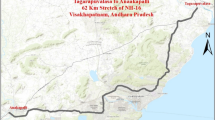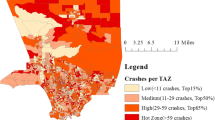Abstract
Pedestrians are one of the most vulnerable road users that are prone to injury and death. Various factors have been incorporated into transportation systems in order to improve pedestrian safety in recent studies. The main objective of this study is to develop a segment-based micro-level geospatial-based approach to find the interaction between the frequency of pedestrian crashes and roadside land uses in rural roads. The proposed approach uses geospatial functions for extracting contributing factors and two different lengths of road segments as analysis units to reduce the randomness of the crash locations. These spatial factors are used to estimate the number of pedestrian crashes in each segment using four count-based regression models, including Poisson, negative binomial (NB) regression models, and their zero-inflated extensions. The latest four-year reporting crashes and land use data for a four-lane divided rural multilane in Guilan province, Iran, were tested to illustrate the models' accuracy and performance in the proposed approach. Modeling results highlighted the superiority of the Poisson regression model and its zero-inflated extension for two different strategies of segment length. Moreover, the results showed that residential, commercial, governmental, institutional, utility, and religious land uses have various decisive impacts on the increase of pedestrian crash frequency. This information could be used in long-term transportation systems planning, which would lead to an improvement in pedestrian safety levels.








Similar content being viewed by others
References
World Health Organization. Global status report on road safety 2018: Summary. No. WHO/NMH/NVI/18.20. World Health Organization, 2018
Loo, Becky PY, and Tessa Kate Anderson. Spatial analysis methods of road traffic collisions. CRC Press, 2015
Effati, M., et al.: Prediction of crash severity on two-lane, two-way roads based on fuzzy classification and regression tree using geospatial analysis. J. Comput. Civ. Eng. 29(6), 04014099 (2014)
Pulugurtha, S.S., Duddu, V.R., Kotagiri, Y.: Traffic analysis zone level crash estimation models based on land use characteristics. Accid. Anal. Prev. 50(Supplement C), 678–687 (2013)
Effati, M., Thill, J.-C., Shabani, S.: Geospatial and machine learning techniques for wicked social science problems: analysis of crash severity on a regional highway corridor. J. Geogr. Syst. 17(2), 107–135 (2015)
Duddu, V.R., Pulugurtha, S.S.: Modeling Link-Level Crash Frequency Using Integrated Geospatial Land Use Data and On-Network Characteristics. J. Transp. Eng. A 143(8), 04017030 (2017)
Kim, K., Yamashita, E.: Motor Vehicle Crashes and Land Use: Empirical Analysis from Hawaii. Transp. Res. Rec. J. Transp. Res. Board 1784, 73–79 (2002)
Kim, K., Brunner, I., Yamashita, E.: Influence of Land Use, Population, Employment, and Economic Activity on Accidents. Transp. Res. Rec. 1953, 56–64 (2006)
PriyanthaWedagama, D.M., Bird, R.N., Metcalfe, A.V.: The influence of urban land-use on non-motorised transport casualties. Accid. Anal. Prev. 38(6), 1049–1057 (2006)
Dissanayake, D., Aryaija, J., Wedagama, D.M.P.: Modelling the effects of land use and temporal factors on child pedestrian casualties. Accid. Anal. Prev. 41(5), 1016–1024 (2009)
Ding, C., Chen, P., Jiao, J.: Non-linear effects of the built environment on automobile-involved pedestrian crash frequency: A machine learning approach. Accid. Anal. Prev. 112, 116–126 (2018)
Chen, P., Zhou, J.: Effects of the built environment on automobile-involved pedestrian crash frequency and risk. J. Transp. Health 3(4), 448–456 (2016)
Mansfield, T.J., et al.: The effects of roadway and built environment characteristics on pedestrian fatality risk: A national assessment at the neighborhood scale. Accid. Anal. Prev. 121, 166–176 (2018)
Miranda-Moreno, L.F., Morency, P., El-Geneidy, A.M.: The link between built environment, pedestrian activity and pedestrian–vehicle collision occurrence at signalized intersections. Accid. Anal. Prev. 43(5), 1624–1634 (2011)
Ukkusuri, S., et al.: The role of built environment on pedestrian crash frequency. Saf. Sci. 50(4), 1141–1151 (2012)
Loukaitou-Sideris, A., Liggett, R., Sung, H.-G.: Death on the Crosswalk: A Study of Pedestrian-Automobile Collisions in Los Angeles. J. Plan. Educ. Res. 26(3), 338–351 (2007)
Wier, M., et al.: An area-level model of vehicle-pedestrian injury collisions with implications for land use and transportation planning. Accid. Anal. Prev. 41(1), 137–145 (2009)
Clifton, K.J., Burnier, C.V., Akar, G.: Severity of injury resulting from pedestrian–vehicle crashes: What can we learn from examining the built environment? Transp. Res. D Transp. Environ. 14(6), 425–436 (2009)
Toran Pour, A., et al.: Neighborhood Influences on Vehicle-Pedestrian Crash Severity. J. Urban Health 94(6), 855–868 (2017)
Mukherjee, D., Mitra, S.: Impact of Road Infrastructure Land Use and Traffic Operational Characteristics on Pedestrian Fatality Risk: A Case Study of Kolkata, India. Transp. Dev. Econ. 5(2), 6 (2019)
Washington, Simon. Incorporating safety into long-range transportation planning. Vol. 62. Transportation Research Board, 2006.
Yang, B.Z., Loo, B.P.Y.: Land use and traffic collisions A link-attribute analysis using Empirical Bayes method. Accid. Anal. Prev. 95(Part A), 236–249 (2016)
Mannering, F.L., Shankar, V., Bhat, C.R.: Unobserved heterogeneity and the statistical analysis of highway accident data. Anal. Methods Accid. Res. 11, 1–16 (2016)
Kim, K., Pant, P., Yamashita, E.: Accidents and Accessibility. Transp. Res. Rec. 2147, 9–17 (2010)
Kaygisiz, Ö., Senbil, M., Yildiz, A.: Influence of urban built environment on traffic accidents: The case of Eskisehir (Turkey). Case Stud. Transp. Policy 5(2), 306–313 (2017)
Vuong, Quang H. "Likelihood ratio tests for model selection and non-nested hypotheses." Econometrica 57(2), 307-333 (1989)
Desmarais, B.A., Harden, J.J.: Testing for zero inflation in count models: Bias correction for the Vuong test. Stata J 13(4), 810–835 (2013)
Akaike, Hirotugu. "Factor analysis and AIC." In Selected papers of Hirotugu Akaike. Springer, New York, NY, 371-386 (1987)
Schwarz, G.: Estimating the dimension of a model. Ann. Stat. 6(2), 461–464 (1978)
Akaike, Hirotogu. “Information theory and an extension of the maximum likelihood principle.” In Selected papers of Hirotugu Akaike, Springer, New York, NY, 199-213 (1998)
Songpatanasilp, Paweenuch, Harutoshi Yamada, Teerayut Horanont, and Ryosuke Shibasaki. “Traffic accidents risk analysis based on road and land use factors using GLMs and zero-inflated models.” In Proceedings of 14th International Conference on Computers in Urban Planning and Urban Management (CUPUM 2015), 7-10. (2015)
Saheli, Mahyar Vahedi, and Meysam Effati. “Investigation of factors contributing to pedestrian crash severity in rural roads.” J. Inj. Violence Res. 11(4) Suppl 2 (2019).
Benekohal, R.F., Hashmi, A.M.: Procedures for estimating accident reductions on two-lane highways. J. Transp. Eng. 118(1), 111–129 (1992)
Mukoko, Kanya K., and Srinivas S. Pulugurtha. “Examining the influence of network, land use, and demographic characteristics to estimate the number of bicycle-vehicle crashes on urban roads.” IATSS research 44(1), 8-16 (2020)
Miaou, S.-P.: The relationship between truck accidents and geometric design of road sections: Poisson versus negative binomial regressions. Accid. Anal. Prev. 26(4), 471–482 (1994)
Washington, Simon, Matthew G. Karlaftis, Fred Mannering, and Panagiotis Anastasopoulos. Statistical and Econometric Methods for Transportation Data Analysis. CRC Press, 2020
Gu, Zongni, and Binbin Peng. “Investigation into the built environment impacts on pedestrian crash frequencies during morning, noon/afternoon, night, and during peak hours: a case study in Miami County, Florida.” J. Transp. Saf. Secur. 1-21 (2019)
Acknowledgments
This study is part of a master’s thesis supported by the Planning & Budget Office of Iran Road Maintenance and Transportation Organization (RMTO). The authors appreciate their support and help in this project.
Author information
Authors and Affiliations
Corresponding author
Ethics declarations
Conflict of Interest
On behalf of all authors, the corresponding author states that there is no conflict of interest.
Additional information
Publisher’s Note
Springer Nature remains neutral with regard to jurisdictional claims in published maps and institutional affiliations.
Rights and permissions
About this article
Cite this article
Vahedi Saheli, M., Effati, M. Segment-Based Count Regression Geospatial Modeling of the Effect of Roadside Land Uses on Pedestrian Crash Frequency in Rural Roads . Int. J. ITS Res. 19, 347–365 (2021). https://doi.org/10.1007/s13177-020-00250-1
Received:
Revised:
Accepted:
Published:
Issue Date:
DOI: https://doi.org/10.1007/s13177-020-00250-1




